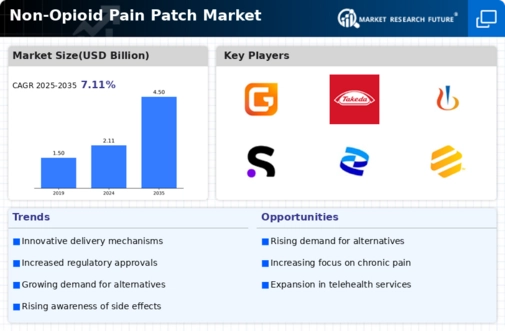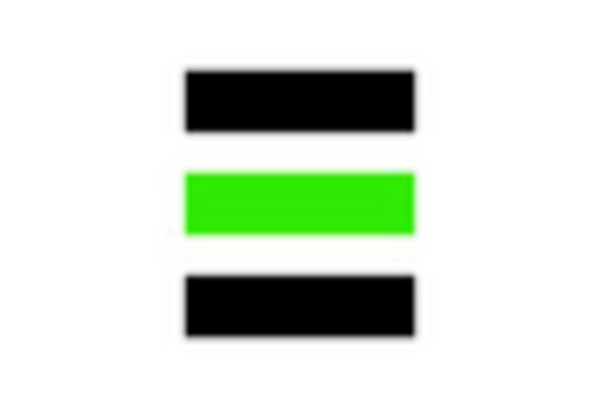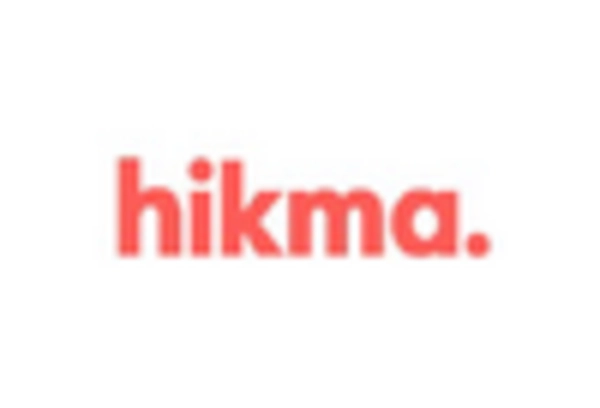Advancements in Patch Technology
Technological innovations in the development of non-opioid pain patches are significantly influencing the Non-Opioid Pain Patch Market. Enhanced delivery systems, such as microneedle technology and transdermal patches, are improving the efficacy and patient compliance of these products. These advancements allow for more precise dosing and sustained release of active ingredients, which can lead to better pain management outcomes. Market analysts project that the integration of smart technology into pain patches, enabling real-time monitoring and personalized treatment, will further propel market growth. As these technologies evolve, they are likely to attract both healthcare providers and patients, thereby expanding the market for non-opioid pain patches.
Support from Healthcare Professionals
The endorsement of non-opioid pain management strategies by healthcare professionals is a crucial driver for the Non-Opioid Pain Patch Market. As medical practitioners increasingly recognize the importance of addressing the opioid crisis, they are advocating for alternative pain management solutions. This professional support is likely to enhance patient trust and acceptance of non-opioid pain patches. Furthermore, educational initiatives aimed at healthcare providers are fostering a better understanding of the benefits and applications of these patches. As more practitioners recommend non-opioid options, the market is poised for growth, with an increasing number of patients seeking these alternatives for effective pain relief.
Rising Incidence of Chronic Pain Conditions
The prevalence of chronic pain conditions is on the rise, contributing to the expansion of the Non-Opioid Pain Patch Market. Conditions such as arthritis, fibromyalgia, and neuropathic pain are increasingly common, leading to a heightened demand for effective pain management solutions. According to recent statistics, nearly 20% of adults experience chronic pain, which underscores the urgent need for innovative treatments. Non-opioid pain patches present a viable option for patients seeking relief without the risks associated with traditional opioid medications. As healthcare systems strive to address the growing burden of chronic pain, the market for non-opioid pain patches is expected to flourish, providing a critical solution for millions of individuals.
Increasing Awareness of Non-Opioid Alternatives
The Non-Opioid Pain Patch Market is experiencing a surge in awareness regarding non-addictive pain management solutions. As healthcare providers and patients alike become more informed about the risks associated with opioid use, there is a growing preference for alternatives that do not carry the same potential for addiction. This shift in perception is likely to drive demand for non-opioid pain patches, as they offer effective pain relief without the adverse effects associated with opioids. Market data indicates that the non-opioid pain management segment is projected to grow significantly, with an estimated compound annual growth rate of over 10% in the coming years. This trend suggests a robust market potential for non-opioid pain patches as they become a preferred choice for pain management.
Growing Preference for Home Healthcare Solutions
The trend towards home healthcare is reshaping the Non-Opioid Pain Patch Market. Patients increasingly prefer to manage their pain in the comfort of their homes, leading to a demand for convenient and effective pain relief options. Non-opioid pain patches align well with this trend, as they are easy to use and can be self-administered. The rise of telehealth services and remote patient monitoring further supports this shift, as patients seek solutions that allow them to maintain their independence while effectively managing their pain. Market data suggests that the home healthcare segment is expected to grow at a rapid pace, indicating a favorable environment for non-opioid pain patches as a preferred choice for at-home pain management.

















